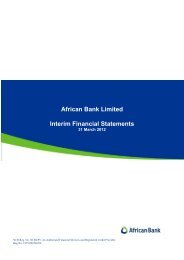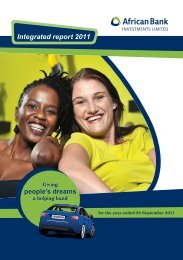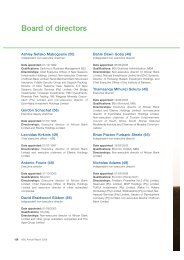Download - African Bank
Download - African Bank
Download - African Bank
Create successful ePaper yourself
Turn your PDF publications into a flip-book with our unique Google optimized e-Paper software.
Management discussion continued<br />
180<br />
160<br />
140<br />
120<br />
100<br />
80<br />
60<br />
<strong>African</strong> <strong>Bank</strong> Retail sales<br />
(Indexed)<br />
<strong>African</strong> <strong>Bank</strong> Retail has a fairly even mix<br />
of repeat clients (60%) and new clients<br />
(40%). In the shorter-term products of CI<br />
and MCG, the repeat client ratios are<br />
much higher at 81% and 93%<br />
respectively.<br />
The average term for new loans in<br />
<strong>African</strong> <strong>Bank</strong> Retail has remained static.<br />
In CI and MCG the average term<br />
increased as these businesses extended<br />
their range of products to include<br />
longer-term products to clients with<br />
a proven credit history with the<br />
businesses.<br />
Portfolio underwriting<br />
margin, costs and tax<br />
Portfolio underwriting margin<br />
The group focuses on managing the risk-<br />
adjusted yield, being the overall yield on<br />
the advances portfolio less net credit<br />
<strong>African</strong> <strong>Bank</strong> Investments Limited 28<br />
Oct Nov Dec Jan Feb Mar Apr May Jun Jul Aug Sep<br />
Operating margin analysis<br />
(% gross interest-bearing advances)<br />
58,4<br />
25,8<br />
9,8<br />
52,7<br />
23,7<br />
6,9<br />
13,1 14,0<br />
losses, as the main measure of<br />
underwriting efficiency.<br />
As anticipated, the overall yield on<br />
the advances book (being interest,<br />
insurance and fees), increased in the<br />
past twelve months to 52,9%, compared<br />
to 49,0% in 2002. The improvement was<br />
the result of the changing mix in the<br />
portfolio to higher yielding debit order<br />
products and the pay down of lower<br />
yielding books. The risk-adjusted yield<br />
during this period was also positively<br />
influenced by the decrease in the<br />
charge for provisions and bad debts<br />
and accordingly increased from 38,4%<br />
to 44,7%.<br />
Net financing costs were flat for the<br />
year, with interest earned on cash<br />
compensating for higher funding costs.<br />
The average cost of funds increased<br />
48,2<br />
25,0<br />
0,1<br />
18,5 17,9 19,1<br />
9,7 8,1<br />
4,6<br />
5,8 5,9<br />
1999<br />
2000 2001 2002 2003<br />
49,0<br />
14,8<br />
10,6<br />
2002<br />
2003<br />
The 2002 sales exclude<br />
R152 million of once-off<br />
Persal consolidation loans<br />
in October to December<br />
from 13,5% to 14,5% during 2003,<br />
although this should begin to decline<br />
as the effect of the lower interest rates<br />
feeds through.<br />
The net effect of the movements in these<br />
profit drivers is that the operating margin<br />
increased by 33% from 14,8% in 2002 to<br />
19,7% in 2003.<br />
Operating efficiency<br />
The cost-to-income ratio at ABIL is<br />
36,2%, relative to the 36,6% in<br />
September 2002. Overall, ABIL’s costs,<br />
after adjusting for the R100 million in<br />
increased costs from the acquisition of<br />
the Saambou PLB, were flat on that for<br />
2002.<br />
<strong>African</strong> <strong>Bank</strong> Retail’s cost reduction<br />
programme continued to prove<br />
effective and yielded operating expenses<br />
52,9<br />
19,7<br />
8,2<br />
Net financing<br />
costs<br />
Operating<br />
expenses<br />
Charge for<br />
bad debt<br />
Operating margin







